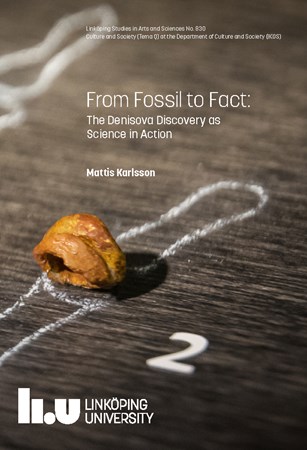Knowledge is not only created by researchers at universities or in labs, but in collaboration with many different actors, over time. This has been very clear in the discovery of the Denisova human.
This is according to Mattis Karlsson, doctor of culture and society, whose doctoral thesis shows that researchers and archaeologists are key players in the discovery of the Denisova human, but that many others have made significant contributions.
”A science network can be broad and contain other actors than the ones we see as scientists. The discovery of the Denisova human provides a nuanced picture of what science can be. The discovery was made – and is still being made – in the Denisova Cave, at the Max Planck Laboratory and in many other places where research is done, but also on platforms where research results are communicated.”
In his doctoral thesis From Fossil To Fact: The Denisova Discovery as Science in Action, Mattis Karlsson studies the discovery of the Denisova human. He analyses the network around the discovery, and the actors and places that have collaborated to create knowledge about the recently discovered human.
He does this by analysing texts about the Denisova human published on various platforms between 2010 and 2021. These texts can be scientific articles, journalistic texts or Wikipedia texts.
The story of the Denisova human
The story of the Denisova human begins in 2008. In the Denisova Cave in Siberia, a group of archaeologists finds a bone fragment. The find is sent to the Max Planck Institute in Germany where scientists successfully sequence its DNA. It turns out that the bone fragment belongs to a previously unknown type of human.
When the first scientific article is published in 2010 in the highly regarded journal Nature, the story becomes public. From this point, things move quickly. Within a few hours a Wikipedia page is created and news sites spread the information around the world.
Because there is little material evidence left from the Denisova human, the story becomes central – it becomes proof that this hominin has existed.
“The shift from the Denisova human not existing to it being born in a conceptual sense and spread around the world occurs extremely rapidly. This evidences extensive infrastructure and a tight informal and formal collaboration between scientists, journalists and Wikipedia.”
According to Mattis Karlsson, this shows that science and the communication of science cannot be separated. They move together and the boundaries are being erased. The scientists are visible on the major news sites and they help to dramatise the story. The way the Wikipedia page is created bears a striking resemblance to the scientific process. The discovery continues in step with the spread of the knowledge.
Science – a part of society
The case of the Denisova human is not unique for how science is done, but it is special in several ways. It is the first time a hominin is discovered by way of DNA analysis. it gives rise to a certain dramaturgy and is followed by political and cultural questions.
”The consequences of this discovery are described as large, often in terms of how it changes the history of human evolution. It also opens for politically charged discussions about the relationship between the people who live today and the people who lived in the past.”
“Here it becomes clear that science is not separated from society. This is why studying the ways in which science is born and the principles behind it is important”, says Mattis Karlsson.
“Historically, science has been considered and studied as a distinct part of society – separate from other social and cultural spheres. But science exists and is made in many places, because the communication of science is also the creation of science.”
Translated by Martin Mirko.

